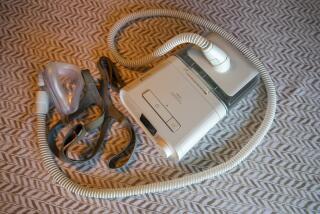Dutch report details European superbug outbreak linked to faulty scopes

Federal regulators issued a nationwide safety alert in February after news broke about a superbug outbreak at UCLA’s Ronald Reagan Medical Center. Above, UCLA officials discuss the scope-related infections.
More than a year before a medical scope infected patients with a superbug at UCLA and Cedars-Sinai medical centers, a similar outbreak in the Netherlands prompted Dutch regulators to ask the manufacturer to prove the device was safe.
Olympus Corp. failed to demonstrate a safe cleaning procedure, according to a new report. As a result, the Dutch hospital that suffered the outbreak, which sickened 22 patients, abandoned the scope for another model without the troublesome design.
The case shows how American regulators and hospitals were left in the dark even as regulators elsewhere concluded that the scopes may be impossible to use and clean safely.
It wasn’t until the Los Angeles Times broke the news of the UCLA outbreak in February that U.S. regulators warned hospitals about the company’s device. By that time, hospitals across the country had experienced outbreaks — some of them deadly. At UCLA’s Ronald Reagan Medical Center, two patients died and five others were sickened.
The report, written by doctors at the Rotterdam hospital, details their investigation into the 2012 outbreak. Like the recent outbreaks in Los Angeles, the Dutch hospital said it cleaned the device according to the company’s instructions. But it didn’t help: The scope still transferred dangerous bacteria from patient to patient.
In a separate outbreak in Germany, a dozen patients were infected with the same bacteria as in UCLA’s, also tied to Olympus scopes.
As a result of the Dutch outbreak, Olympus sent an urgent warning to European hospitals in January 2013, telling them to use a special brush in cleaning the device. The company did not send that letter to U.S. hospitals.
The Dutch doctors’ report is the first full account of the outbreak. The Times reported last month about the company’s European safety alert, but the alert provided no details about what happened or where.
The U.S. Food and Drug Administration, which regulates the safety of medical devices, says it did not learn until last year of the company’s European alert or the Dutch regulators’ report.
The Rotterdam hospital, Erasmus University Medical Center, last used the popular Olympus scope, known as model TJF-Q180V, in March 2012. That’s when doctors at the hospital traced the outbreak’s cause to the scope and brought in the country’s regulators.
All 22 Dutch patients had a procedure involving the scope. And the same dangerous strain of bacteria that sickened them was also found living inside the scope’s intricate recesses.
Mark Miller, a spokesman for Olympus, said the company had cooperated with regulators in the investigation of the Dutch outbreak. He said the company sent the January 2013 European safety alert to remind hospitals of the importance of properly cleaning the scope.
Miller did not answer a question from The Times about why the company did not send the same alert to American hospitals.
In an email Wednesday, an FDA spokeswoman said the agency believes the TJF-Q180V can be safely used when hospitals follow revised cleaning instructions that Olympus sent to hospitals after the Los Angeles outbreaks.
The FDA first warned hospitals Feb. 19 about the hard-to-clean design of the scope sold by Olympus and two other manufacturers.
The agency has scheduled a Thursday meeting to discuss the scope-related outbreaks and what more should be done. Among its questions for doctors on an advisory panel is whether the agency should more quickly warn the public when there are concerns about a device, even when there’s not enough evidence to pinpoint the specific danger.
The Dutch doctors’ report appeared in the medical journal Endoscopy on March 31. They also presented their findings at an international medical conference in Washington, D.C., in September 2014 — a month before the first patient at UCLA became infected.
About the same time that the Dutch report appeared, German doctors published their investigation into a nearly identical outbreak at a hospital in Berlin. The German physicians also blamed the hard-to-clean design of the TJF-Q180V for the outbreak that happened in late 2012 and early 2013.
In all, 12 German patients were infected by the same superbug as those at UCLA and Cedars-Sinai. The outbreak at Berlin’s Charite University hospital ended when doctors sent the scope to Olympus for maintenance.
Olympus began selling its redesigned device, the TJF-Q180V, in 2010.
In sales brochures, the company said the new design allowed for “more efficient reprocessing” — the industry’s term for disinfecting a device and readying it for the next patient.
But the new design actually hampered disinfection, the Dutch doctors wrote in their article.
In the new design, Olympus enclosed the scope’s elevator channel, which enables doctors to move small instruments through the long snake-like device.
Known as duodenoscopes, the devices are flexible lighted tubes that are threaded through a patient’s mouth to the top of the small intestine. They are used to treat problems in the pancreas and bile ducts.
The Dutch doctors had the scope dismantled, finding that the O-ring, which was meant to help seal the elevator channel, had become cracked and worn even though it had been sent to Olympus for repair twice in 13 months.
The Dutch doctors, led by Dr. Margreet Vos, a microbiologist, and Dr. Marco Bruno, a gastroenterologist, said they wrote their report because they wanted to alert other hospitals of the scope’s dangerous design.
They called for any “new features” on a device to be tested and proved safe before they were sold.
The doctors also called for stringent rules that would require device-related infections to be quickly reported and closely followed to provide an early warning of problems.
The Dutch doctors said it was possible that the scope could transfer not just bacteria, but other pathogens including blood-borne viruses such as hepatitis C, hepatitis B and HIV.
They said they were particularly concerned the scope could have spread hepatitis B because the hospital treats a high number of those patients.
But they said they found no evidence that the scope passed along that virus. They also noted that other researchers have said the risk of endoscopes spreading blood-borne viruses is low.
Twitter: @melodypetersen
Twitter: @chadterhune
More to Read
Inside the business of entertainment
The Wide Shot brings you news, analysis and insights on everything from streaming wars to production — and what it all means for the future.
You may occasionally receive promotional content from the Los Angeles Times.










